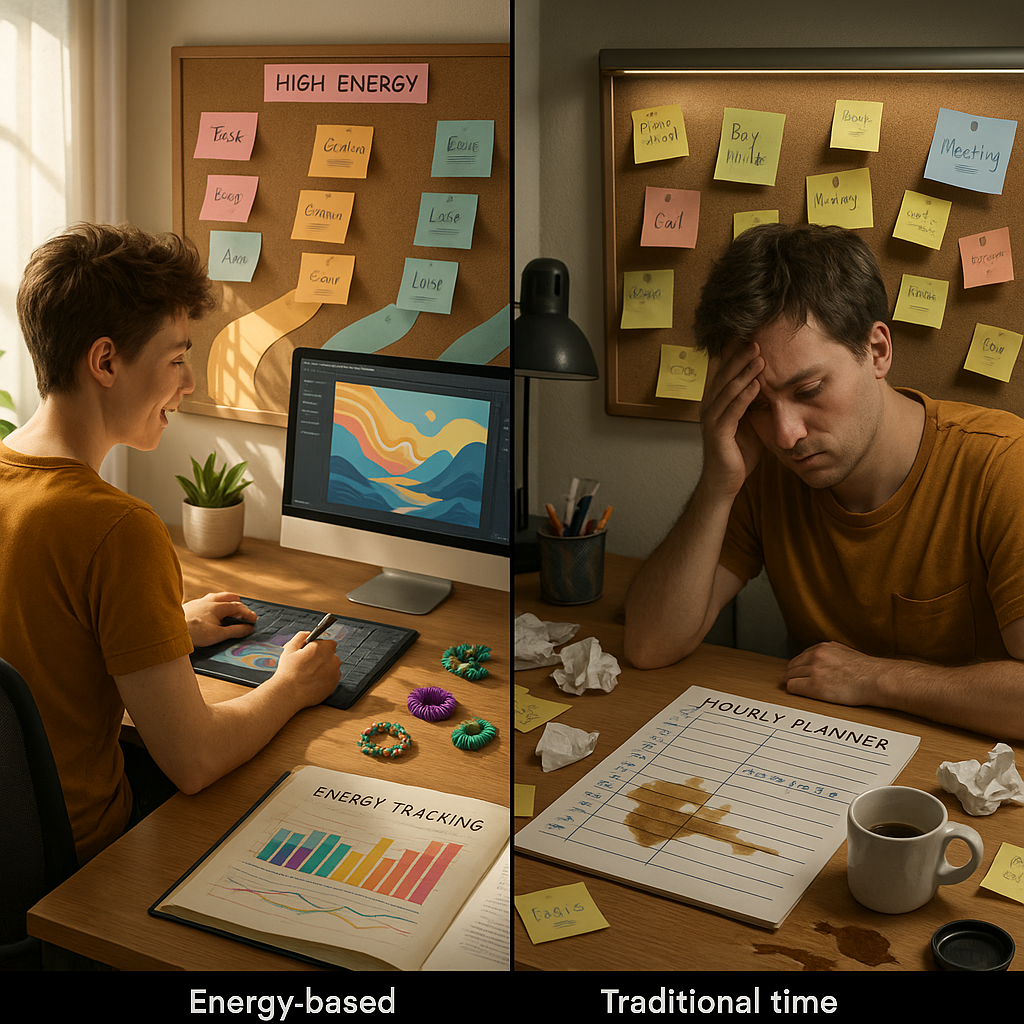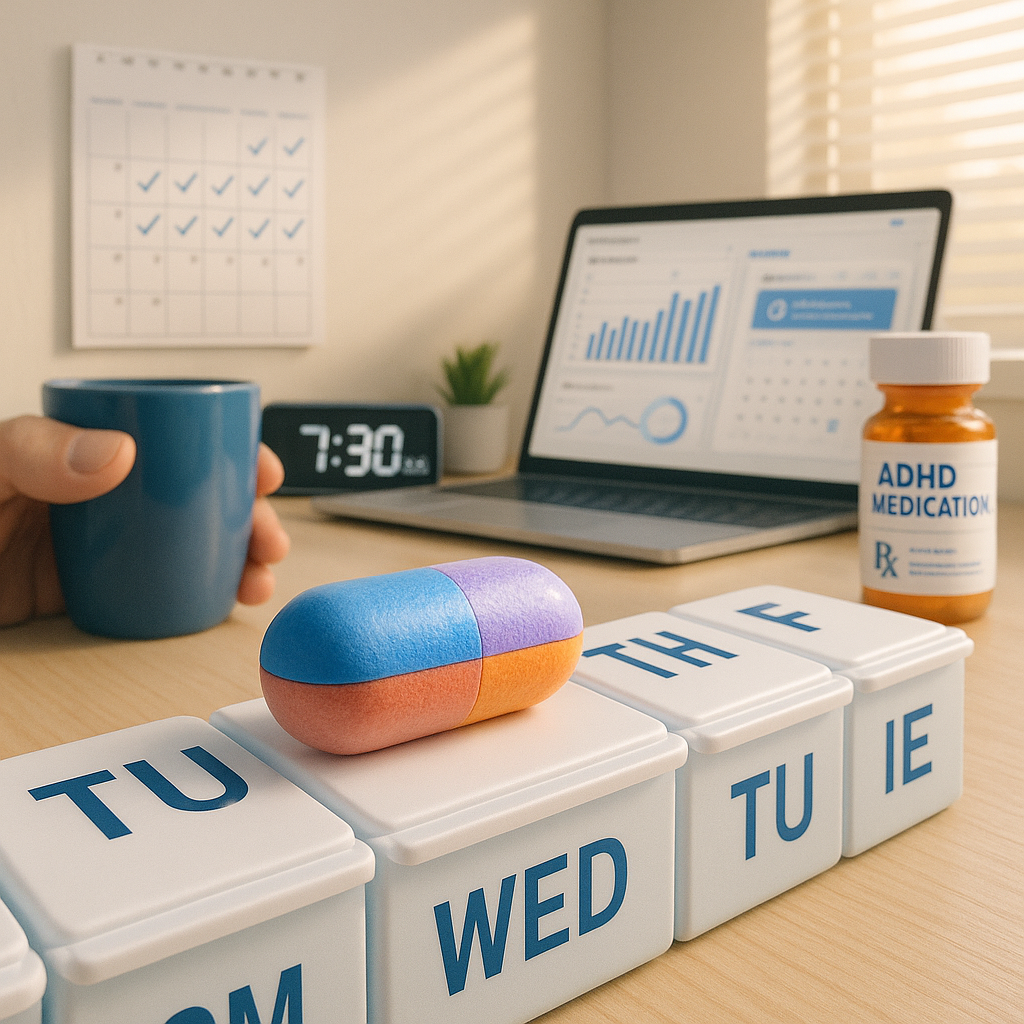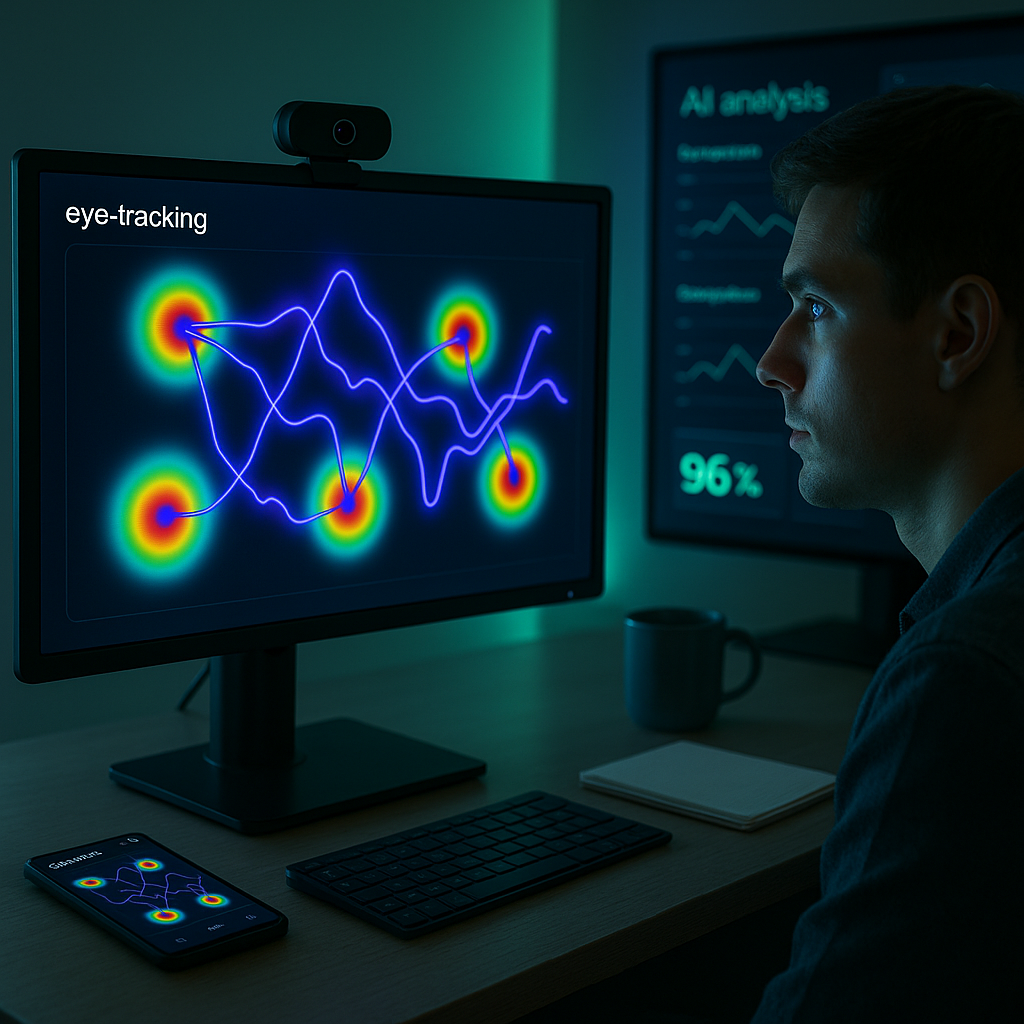Key Takeaways
Finding focus with ADHD isn’t just about downloading a new productivity app or sticking to a rigid calendar. Genuine progress comes from aligning your work with your natural energy cycles, so you’re working with your brain rather than fighting against it. By tuning into your unique rhythms and batching tasks accordingly, you can increase productivity, reduce stress, and transform scattered days into ones with real flow. Here are the essential strategies to unlock more focus and fewer meltdowns:
- Lead with energy, not just the clock: Instead of forcing tasks into strict time slots, batch your work periods based on when you feel most alert, creative, or focused. For neurodivergent minds, energy blocks are often more effective than traditional time blocks.
- Harness your personal ADHD rhythms: Track your high and low energy moments for a few days, then match focused or complex work to your natural peaks. Save routine or maintenance tasks for energy dips.
- Stop paying the “task-switching tax”: Minimizing transitions by grouping similar activities helps avoid the cognitive drain that comes from jumping between different types of tasks, which can be especially exhausting for ADHD brains.
- Custom-fit your system to your brain: Avoid generic productivity templates. Experiment with batching that matches your unique patterns, interests, and sources of motivation.
- Energy-based batching cuts decision fatigue: Pre-deciding what you’ll tackle during each energy block frees up mental resources and makes your workflow smoother and less overwhelming.
- Start small to sidestep burnout: Roll out batching gradually, focusing on one or two energy peaks each day at first so you can adapt without overwhelming yourself or triggering resistance to change.
- Redefine productivity: less force, more flow: For ADHD minds, real productivity means working with your wiring. When you make use of your natural energy cycles, tasks feel lighter and focus increases. Progress becomes easier, and a lot more sustainable.
By embracing these energy-first batching strategies, you can turn a chaotic to-do list into a series of focused, momentum-building sprints. Next, let’s explore how to map your energy rhythms and build a workflow that genuinely fits you.
Introduction
If you’ve ever wondered why no planner or time management tip seems to stick, you’re not alone. For neurodivergent minds (especially those navigating ADHD), traditional systems often feel like trying to harness a lightning storm inside a shoebox. The truth? The “secret” to order isn’t jamming tasks into rigid schedules, but tuning directly into the natural rise and fall of your energy every day.
Task batching, when tailored for ADHD energy management, allows you to capitalize on your intrinsic rhythms. By grouping similar tasks when your focus naturally peaks and reserving lower-demand activities for your slow periods, you minimize mental friction, reduce stress, and recapture those afternoons that used to slip away in a blur.
Throughout this guide, we’ll uncover how to listen to your own energy patterns, batch tasks in ways that make sense for your brain, and develop a workflow that is both motivating and sustainable. Whether you’re a solopreneur, creative professional, healthcare worker, educator, or manager, the principles here are adaptable. They help you do more of your best work, on your terms.
Why Traditional Time Blocks Can Fail With ADHD
While time blocking is often touted as a productivity gold standard, it’s built with neurotypical brains in mind. For those with ADHD or related neurodivergence, it rarely delivers consistent results. This is because ADHD brains operate on a totally different set of rules. They’re driven by interest, urgency, and fluctuating energy levels, not just by the hands of a clock.
Time blocking’s limitations for ADHD include:
- Inflexible Structure Meets Variable Focus: Neurotypical individuals might maintain steady focus during set slots, but ADHDers experience unpredictable waves of engagement throughout the day.
- Misaligned Time Estimates: A task that takes 30 minutes in a hyperfocus state might stretch to two hours during a slump. This variability kills the consistency that time blocking relies on and often leads to frustration or self-doubt.
- Executive Function Barriers: ADHD makes it harder to estimate time accurately, transition smoothly, and sustain attention over predetermined periods. These are critical ingredients for traditional time blocking to succeed.
Take Sarah, a graphic designer with ADHD. After weeks of scheduling 9 to 11 AM for client projects, she realized her creative surges often arrived unexpectedly in the afternoon. Forcing herself into a fixed morning slot led to mental gridlock and left her feeling like she could never “keep up,” not with work but with a system that simply wasn’t made for her mind.
Mapping Your Energy Patterns
The first major step in designing an ADHD-friendly workflow is learning how your energy fluctuates. Rather than fighting to fit yourself into a predetermined structure, you’ll be working with your body and brain. That’s how you unlock more sustainable productivity.
How to Track Your Energy Levels
- Simple Rating System
- High Energy: You feel sharp, enthusiastic, and ready for big challenges.
- Medium Energy: You’re steady and capable of routine or moderately complex tasks.
- Low Energy: Your mind feels foggy, distracted, or resistant to effortful work.
- Identify Patterns Throughout the Day
- Every 2-3 hours, check in with yourself and jot down your current energy state.
- Note factors that raise or lower your energy: certain meetings, meals, medication, exercise, or sleep.
- Keep a running log for at least one week. The insights will be invaluable.
Example log template:
Time | Energy Level (1-5) | Activities | Notes
—|—|—|—
8AM | 3 | Respond to emails | Post-breakfast lift
10AM | 4 | Design concept sketches | Creative streak after coffee
2PM | 2 | Team meeting | Noticed a post-lunch crash
Over time, you’ll spot clear trends. Maybe your creativity spikes before lunch, or you hit a wall by mid-afternoon. Knowing these patterns is the foundation for intelligent batching.
Energy-Based Task Batching for ADHD
Once you understand your energy landscape, you can batch tasks to fit. This approach flips the script. You begin grouping tasks not by category alone, but by the energy they require and the energy you have at that moment.
Types of Task Batches by Energy
High Energy Batches:
- Creative brainstorming (marketing campaigns, lesson planning, code design)
- Strategic problem-solving (business plans, case reviews, diagnosis sessions)
- Learning or mastering new skills (software training, legal research, advanced analytics)
Medium Energy Batches:
- Consultations or client calls
- Reviewing and editing content
- Organizing project files or updating records
- Collaborative tasks like team meetings or class discussions
Low Energy Batches:
- Routine data entry or document filing
- Responding to standard emails or messages
- Housekeeping (virtual or physical), such as tidying up your workspace or filing paperwork
- Administrative maintenance like inventory counts, appointment confirmations, or system checks
This method isn’t limited to business or creative work. In healthcare, for instance, clinics may batch patient intake during staff energy peaks and reserve paperwork for slower hours. In education, teachers might introduce complex topics when student and instructor energy are highest, saving grading or admin for quieter times.
The essential principle: Do the right type of work at the right time, and you’ll experience less resistance. That leads to far more momentum.
Reducing Cognitive Switching Costs and Decision Fatigue
For ADHD brains, mental transitions come with a price. Each time you jump from writing an email to problem-solving or from research to logistics, you “pay” a cognitive switching cost. This constant gear-shifting depletes your focus and ramps up fatigue.
How Strategic Batching Helps
When you batch similar tasks together (whether creative, operational, analytical, or communicative), you reduce the mental load of switching contexts. Here are industry-spanning examples:
- Content Creation Batches: Writing articles, recording podcasts, filming tutorials, or designing visuals together to preserve creative flow.
- Administrative Batches: Processing invoices, updating spreadsheets (for finance professionals), scheduling appointments (for healthcare providers), or grading assignments (in education).
- Analytical Batches: Reviewing reports, conducting research, reading and annotating literature (for legal teams, marketers, or environmental scientists).
- Customer & Client Batches: Scheduling all client follow-up calls in one sitting, fielding customer service emails at once, or setting aside set times for group instruction or patient rounds.
By front-loading decisions and keeping task types consistent within blocks, you dramatically reduce the mental drag of constant prioritizing and refocusing.
Creating a Personalized ADHD Productivity System
No single system works for every neurodivergent brain. The goal is to build a batching workflow that’s flexible, scalable, and personalized to your real needs.
Core Components of Your Workflow
- Energy-Aligned Task Lists
- Break down personal and work tasks by energy requirement.
- Keep daily or weekly templates for high, medium, and low-energy batches.
- Drop the guilt if your capacity shifts day-to-day. Adaptability beats rigidity.
- Environmental Triggers
- Use workspace cues (e.g., sitting at one location for creative work, another for admin tasks).
- Incorporate music or ambient sounds to signal to your brain that it’s time to shift gears.
- Employ visual aids: color-coded task lists, post-it reminders, or project boards.
- Buffer Zones
- Schedule decompression periods between intense batches.
- Include short “reset” windows after complex or emotionally draining work.
- Build in catch-up slots for tasks that spill over. Every ADHD brain knows surprises happen.
- Feedback & Refinement
- Review your batching experiment weekly. Are certain batches too long or too short? Are your actual energy peaks differing from what you expected?
- Adjust based on lived experience. Your brain is the best data source you have.
Redefining Productivity for ADHD Brains
Genuine ADHD productivity is not about squeezing yourself into a neurotypical mold. True progress comes from embracing intensity, honoring your cycles, and creating systems that adapt to you, not the other way around.
- Embrace Intensity: Riding those bursts of hyperfocus isn’t a flaw; it’s a superpower when focused on the right tasks.
- Honor Your Rhythms: Protect your most creative or insightful windows and show yourself grace during natural dips.
- Track Results, Not Just Hours: Measure progress by tangible outcomes. Projects moved forward, goals achieved. Don’t chase the illusion of constant, linear effort.
- Prioritize Sustainability: Burning out helps no one. Instead, build systems that keep your energy tank from running dry so you can deliver quality work consistently.
This mindset shift applies whether you’re charting a business growth plan, caring for patients, teaching a classroom, or innovating in tech or consumer services. As one software developer with ADHD found, “When I batched documentation and routine coding for my slower afternoons, and reserved mornings for deep-focus problem-solving, my productivity and wellbeing dramatically improved.”
Conclusion
Relying on traditional time blocking often leaves neurodivergent professionals locked in a cycle of frustration, trying to conform to systems that ignore the nuances of real-life brains. By charting your energy cycles and batching tasks based on your natural rhythms, you transform what previously felt like obstacles (scattered focus, impulsive creativity, variable energy) into real assets for creative output and consistent progress.
Energy-based batching isn’t a productivity fad. It’s a strategy for reclaiming control, agency, and sustained excellence. As work grows more complex and demands rise across industries (from startups and clinical practices to classrooms and marketing teams), those who adapt their workflows to their actual brains will lead with both impact and resilience.
The next era of productivity isn’t about “fixing” your neurodivergence. It’s about building systems that harness it. When your workflow is finally shaped by your own rhythm instead of someone else’s rules, “Not Broken. Brilliant.” becomes more than a motto. It becomes your reality. Ask yourself: What possibilities will open up when you create with your natural energy, not in spite of it? The future belongs to those who leverage their difference as their greatest strength.





Leave a Reply